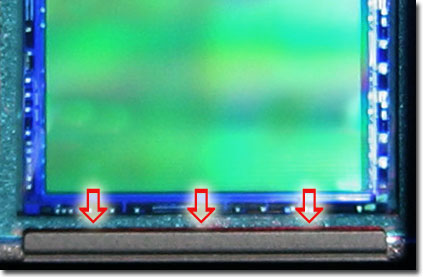Advantages and warnings
Now it is time for a short discussion of who can and should use Sensor-Film and what things you have to pay attention to?
Sensor-Film cleaning is not the easiest thing in the world but you don't need to be a rocket scientist to do it successfully. You need a calm hand, cool mind, and good eyes. These are attributes everybody cleaning a DSLR sensor should have, regardless of the chosen cleaning method. So what are the things you should attend to and what are the absolute NO-NOs?
-
Try not to paint on the covering framework (clamps) which hold the filter glass in place.
< Removing the foil could be problematic on some camera models. > -
The camera has to remain horizontally until you are absolutely sure the film has dried. This is even more important if you dry with closed shutter.
< Parts of the foil could become too thin and some too thick. In extreme cases the shutter could get glued. > -
When you cut the paper slash don't make it too long. After gluing it to the film it has to fit between filter glass and shutter.
< This is your insurance that in case of power loss the shutter won't get damaged. > -
Always paint the whole sensor with Sensor-Film and not only the parts you think are dirty or have remnants.
< Not covered sensor parts would accumulate dust during the film has to dry. >

Comparison with other cleaning methods
Advantages
- Sensor-Film does not leave residues after drying and peeling off.
- There is no risk to scratch your sensor.
- With this method the dust is really removed from your sensor and not just shifted to another edge.
- Sensor-Film does not forget dust grains. Any area which had contact with the film will be dust free.
Disadvantages
- It takes long until the film has dried.
- You have to follow the instructions exactly.
- Sensor-Film can only remove water soluble materials. Fingerprints for example will not be removed completely.